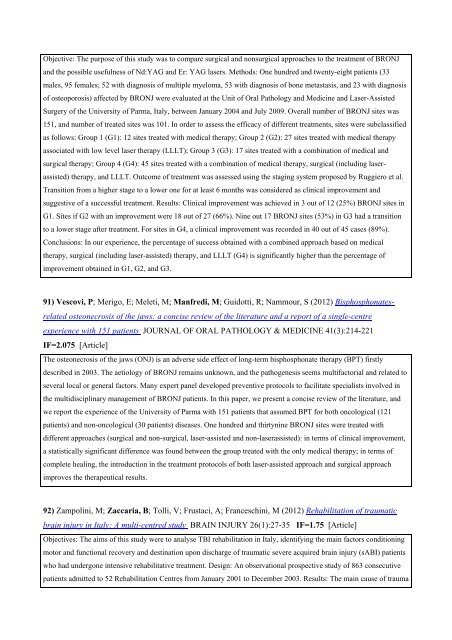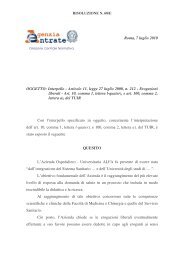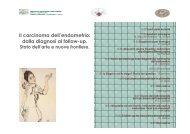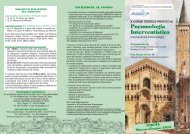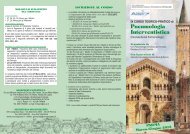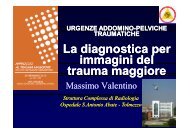COLLEGIO DI DIREZIONE - Azienda Ospedaliera di Parma
COLLEGIO DI DIREZIONE - Azienda Ospedaliera di Parma
COLLEGIO DI DIREZIONE - Azienda Ospedaliera di Parma
You also want an ePaper? Increase the reach of your titles
YUMPU automatically turns print PDFs into web optimized ePapers that Google loves.
Objective: The purpose of this study was to compare surgical and nonsurgical approaches to the treatment of BRONJ<br />
and the possible usefulness of Nd:YAG and Er: YAG lasers. Methods: One hundred and twenty-eight patients (33<br />
males, 95 females; 52 with <strong>di</strong>agnosis of multiple myeloma, 53 with <strong>di</strong>agnosis of bone metastasis, and 23 with <strong>di</strong>agnosis<br />
of osteoporosis) affected by BRONJ were evaluated at the Unit of Oral Pathology and Me<strong>di</strong>cine and Laser-Assisted<br />
Surgery of the University of <strong>Parma</strong>, Italy, between January 2004 and July 2009. Overall number of BRONJ sites was<br />
151, and number of treated sites was 101. In order to assess the efficacy of <strong>di</strong>fferent treatments, sites were subclassified<br />
as follows: Group 1 (G1): 12 sites treated with me<strong>di</strong>cal therapy; Group 2 (G2): 27 sites treated with me<strong>di</strong>cal therapy<br />
associated with low level laser therapy (LLLT); Group 3 (G3): 17 sites treated with a combination of me<strong>di</strong>cal and<br />
surgical therapy; Group 4 (G4): 45 sites treated with a combination of me<strong>di</strong>cal therapy, surgical (inclu<strong>di</strong>ng laserassisted)<br />
therapy, and LLLT. Outcome of treatment was assessed using the staging system proposed by Ruggiero et al.<br />
Transition from a higher stage to a lower one for at least 6 months was considered as clinical improvement and<br />
suggestive of a successful treatment. Results: Clinical improvement was achieved in 3 out of 12 (25%) BRONJ sites in<br />
G1. Sites if G2 with an improvement were 18 out of 27 (66%). Nine out 17 BRONJ sites (53%) in G3 had a transition<br />
to a lower stage after treatment. For sites in G4, a clinical improvement was recorded in 40 out of 45 cases (89%).<br />
Conclusions: In our experience, the percentage of success obtained with a combined approach based on me<strong>di</strong>cal<br />
therapy, surgical (inclu<strong>di</strong>ng laser-assisted) therapy, and LLLT (G4) is significantly higher than the percentage of<br />
improvement obtained in G1, G2, and G3.<br />
91) Vescovi, P; Merigo, E; Meleti, M; Manfre<strong>di</strong>, M; Guidotti, R; Nammour, S (2012) Bisphosphonatesrelated<br />
osteonecrosis of the jaws: a concise review of the literature and a report of a single-centre<br />
experience with 151 patients JOURNAL OF ORAL PATHOLOGY & ME<strong>DI</strong>CINE 41(3):214-221<br />
IF=2.075 [Article]<br />
The osteonecrosis of the jaws (ONJ) is an adverse side effect of long-term bisphosphonate therapy (BPT) firstly<br />
described in 2003. The aetiology of BRONJ remains unknown, and the pathogenesis seems multifactorial and related to<br />
several local or general factors. Many expert panel developed preventive protocols to facilitate specialists involved in<br />
the multi<strong>di</strong>sciplinary management of BRONJ patients. In this paper, we present a concise review of the literature, and<br />
we report the experience of the University of <strong>Parma</strong> with 151 patients that assumed BPT for both oncological (121<br />
patients) and non-oncological (30 patients) <strong>di</strong>seases. One hundred and thirtynine BRONJ sites were treated with<br />
<strong>di</strong>fferent approaches (surgical and non-surgical, laser-assisted and non-laserassisted): in terms of clinical improvement,<br />
a statistically significant <strong>di</strong>fference was found between the group treated with the only me<strong>di</strong>cal therapy; in terms of<br />
complete healing, the introduction in the treatment protocols of both laser-assisted approach and surgical approach<br />
improves the therapeutical results.<br />
92) Zampolini, M; Zaccaria, B; Tolli, V; Frustaci, A; Franceschini, M (2012) Rehabilitation of traumatic<br />
brain injury in Italy: A multi-centred study BRAIN INJURY 26(1):27-35 IF=1.75 [Article]<br />
Objectives: The aims of this study were to analyse TBI rehabilitation in Italy, identifying the main factors con<strong>di</strong>tioning<br />
motor and functional recovery and destination upon <strong>di</strong>scharge of traumatic severe acquired brain injury (sABI) patients<br />
who had undergone intensive rehabilitative treatment. Design: An observational prospective study of 863 consecutive<br />
patients admitted to 52 Rehabilitation Centres from January 2001 to December 2003. Results: The main cause of trauma


